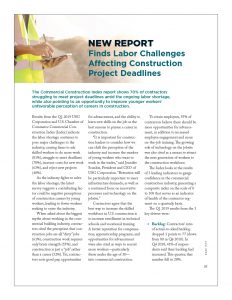New Report Finds Labor Challenges Affecting Construction Project Deadlines
The Commercial Construction Index report shows 70% of contractors struggling to meet project deadlines amid the ongoing labor shortage, while also pointing to an opportunity to improve younger workers’ unfavorable perception of careers in construction.

Results from the Q1 2019 USG Corporation and U.S. Chamber of Commerce Commercial Construction Index (Index) indicate the labor shortage continues to pose major challenges to the industry, causing firms to ask skilled workers to do more work (81%), struggle to meet deadlines (70%), increase costs for new work (63%), and reject new projects (40%).
As the industry fights to solve the labor shortage, the latest survey suggests a contributing factor could be negative perceptions of construction careers by young workers, leading to fewer workers seeking to enter the industry.
When asked about the biggest myths about working in the commercial building industry, contractors cited the perception that construction jobs are all “dirty” jobs (61%), construction work requires only brute strength (55%), and construction is just a “job” rather than a career (52%). Yet, contractors note good pay, opportunities for advancement, and the ability to learn new skills on the job as the best reasons to pursue a career in construction.
“It is important for construction leaders to consider how we can shift the perception of the industry and increase the number of young workers who want to work in the trades,” said Jennifer Scanlon, President and CEO of USG Corporation. “Retention will be particularly important to meet infrastructure demands, as well as a continued focus on innovative processes and technology on the jobsite.”
Contractors agree that the best way to increase the skilled workforce in U.S. construction is to increase enrollment in technical schools and vocational training. A better reputation for compensation, apprenticeship programs, and opportunities for advancement were also cited as ways to recruit more workers—particularly those under the age of 30—into commercial construction.
To retain employees, 55% of contractors believe there should be more opportunities for advancement, in addition to increased employee engagement and more on-the-job training. The growing role of technology on the jobsite was also cited as a means to attract the next generation of workers to the construction workforce.
The Index looks at the results of 3 leading indicators to gauge confidence in the commercial construction industry, generating a composite index on the scale of 0 to 100 that serves as an indicator of health of the contractor segment on a quarterly basis.
The Q1 2019 results from the 3 key drivers were:
- Backlog: Contractors’ ratio of actual-to-ideal backlog dropped 3 points to 77 (down from 80 in Q4 2018). In Q4 2018, 41% of respondents said their backlog had increased. This quarter, that number fell to 28%.
- New Business Confidence: The level of overall confidence dropped 5 points (from 76 to 71) quarter-over-quarter.
- Revenue: The revenue driver dropped 2 points to 67 this quarter, indicating moderated expectations for the magnitude of revenue growth in the next 12 months.
The research was developed with Dodge Data & Analytics (DD&A), the leading provider of insights and data for the construction industry, by surveying commercial and institutional contractors.
Overall, the Q1 composite score of 72 shows a healthy market, though contractors may be slightly more cautious about the health of the commercial construction industry, evidenced by a drop in the 3 leading indicators—backlog, new business, and revenue forecasts. The survey was fielded in January, during the federal government shutdown, so concerns about economic stability and future growth were likely more top-of-mind than in previous surveys. However, the data about industry perceptions should still be troubling to anyone looking to solve the prevailing labor shortage. “The first quarter findings suggests that the fundamentals of the construction industry remain strong, but to sustain future growth, it is clear that we need bipartisan policy solutions from Washington that promote trade, reform our immigration system, and better prepare America’s workforce for the jobs of today and tomorrow,” said Neil Bradley, U.S. Chamber of Commerce Executive Vice President and Chief Policy Officer.
About the Index
The Index is a quarterly economic index designed to gauge the outlook for, and resulting confidence in, the commercial construction industry. USG Corporation and the U.S. Chamber produce this Index, along with DD&A. Each quarter, researchers from DD&A source responses from their Contractor Panel of more than 2,700 commercial construction decision-makers in order to better understand their levels of confidence in the industry and other key trends. This panel allows DD&A to provide findings that are representative of the entire U.S. construction industry by geography, size, and type of company. Each quarterly Index published is available on the USG Corporation website at www.usg.com/commercialconstructionindex as well as on the website www.CommercialConstructionIndex.com.Visit www.uschamber.com/report/usg-us-chamber-of-commerce-commercial-construction-index-2019-q1 to see the full report, methodology, and graphics.
Note: Please note the Commercial Construction Index report is intended for general informational purposes only. It is not intended to support an investment decision with respect to USG Corporation, nor is it intended to be used for marketing purposes to any existing or prospective investor of USG. This report is not a forecast of future results for USG, and actual results of USG may differ materially from those of the commercial construction industry. Note, too, that the Index reports on conditions across the entire construction industry. As such, results may vary substantially from reports focused specifically on the mechanical insulation and laminated metal building insulation industry segments.
